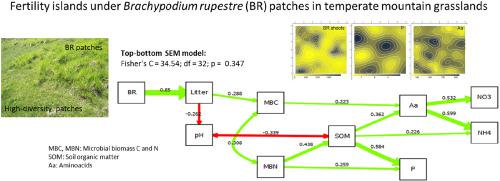Soil Biology and Biochemistry ( IF 9.8 ) Pub Date : 2021-10-07 , DOI: 10.1016/j.soilbio.2021.108455 Leticia San Emeterio 1 , María Durán 1 , Leire Múgica 1 , Juan J. Jiménez 2 , Rosa Maria Canals 1

|
Plant-soil feedback mechanisms influence the abundance and rarity of plant species and can favour invasive processes, including those of native species. To explore these mechanisms, we analysed correlations between spatial distributions of plant biomass and soil properties in two neighbouring grasslands at different phases of expansion of the native Eurasian tall-grass Brachypodium rupestre (Host) Roem & Schult (B. rupestre cover: >75 and 25–50%). For this, we applied spatially explicit sampling, geostatistical analysis and structural equation models (SEM) to probe causal relationships among measured variables involved in nutrient accumulation. We hypothesized that if litter accumulates as a result of reduced grazing, ‘fertility islands’ (spots of high SOM and nutrient contents) will form under B. rupestre clumps because the increase in resource inputs from litter will trigger SOM build-up and promote microbial growth. Our results show that ‘fertility islands’ of P and amino acids occurred under the patchy clumps of B. rupestre in the less invaded grassland. In addition, the SEMs indicated that nutrient accumulation was partially due to mineralization of the SOM and modulated by the soil microbial biomass. However, there was no correlation between spatial patterns of B. rupestre biomass, SOM and microbial biomass. Moreover, the SEMs explained small amounts of variance in them (SOM r2 = 0.22 and microbial biomass r2 = 0.08), suggesting that factors other than B. rupestre biomass were responsible for the high fertility below the patches. Our spatially explicit approach demonstrated that litter inputs in dense temperate grassland communities can generate ‘fertility islands’ that may favour the stability and expansion of a tall-grass invader and suggest that herbivory may enhance or inhibit this phenomenon.
中文翻译:

温带山地草原高草空间分布与肥力岛的关系
植物-土壤反馈机制影响植物物种的丰度和稀有性,并有利于入侵过程,包括本地物种的入侵过程。为了探索这些机制,我们分析了两个相邻草地在原生欧亚高草Brachypodium rupestre (Host) Roem & Schult ( B. rupestre覆盖率:>75 和 25–50%)。为此,我们应用空间显式采样、地质统计分析和结构方程模型 (SEM) 来探测与养分积累有关的测量变量之间的因果关系。我们假设,如果由于放牧减少导致凋落物堆积,B. rupestre丛下将形成“肥沃岛”(高 SOM 和营养含量的点),因为来自凋落物的资源投入的增加将触发 SOM 积累并促进微生物生长。我们的结果表明 P 和氨基酸的“生育岛”发生在B. rupestre的斑块下在入侵较少的草原上。此外,SEMs 表明养分积累部分是由于 SOM 的矿化和土壤微生物生物量的调节。然而,B. rupestre生物量、SOM 和微生物生物量的空间格局之间没有相关性。此外,SEM 解释了其中的少量差异(SOM r 2 = 0.22 和微生物生物量 r 2 = 0.08),表明除B. rupestre 之外的其他因素生物量是造成斑块下方高肥力的原因。我们的空间明确方法表明,密集的温带草原群落中的凋落物输入可以产生“肥沃岛”,这可能有利于高草入侵者的稳定和扩张,并表明食草动物可能会增强或抑制这种现象。











































 京公网安备 11010802027423号
京公网安备 11010802027423号